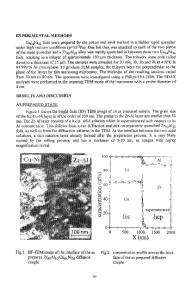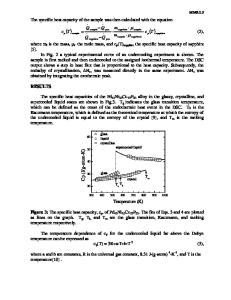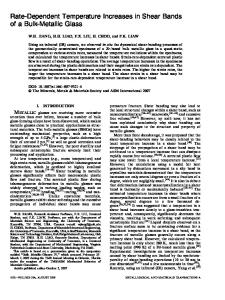Time Dependent Nucleation in a Bulk Metallic Glass Forming Alloy
- PDF / 984,261 Bytes
- 6 Pages / 414.72 x 648 pts Page_size
- 31 Downloads / 315 Views
of the undercooled liquid or amorphous phase [3-4]. Studies of the time-dependent nucleation in these systems can better reveal the mechanism leading to the fine-scale devitrification by probing the cluster dynamics underlying the nucleation process. The slow crystallization kinetics of these glasses allow more direct measurements of transient nucleation behavior to be made than have been made in other metallic glasses, such as Ti2Ni [5] and Co-Zr[6]. There, a time-dependent nucleation rate was inferred from single-step annealing treatments. The convolution of nucleation and growth processes in such measurements and the failure to account for all post-critical nuclei, however, make a quantitative interpretation of such data difficult. Here we present the first measurements of the nucleation rate obtained from multistep annealing treatments, common for silicate glasses[7]. Measurements in Zr65A17 .5 Ni10 CU]7 .5 glasses clearly show evidence for a transient nucleation rate. EXPERIMENT Alloys were prepared by mixing the constituent elements (Zr 99.8%, Al 99.99%, Ni 99.99%, and Cu 99.99%) in the desired proportions. These were alloyed by DC arc-melting in a water-cooled copper hearth under a gettered argon atmosphere. The resulting ingots were broken; portions were melted in argon with rf-induction heating and rapidly solidified onto a rotating copper wheel (60m/s). Glassy ribbons were produced with typical dimensions of 2.0 mm width and 0.01 mm thickness. The amorphous ribbons are believed to be homogeneous 137 Mat. Res. Soc. Symp. Proc. Vol. 481 0 1998 Materials Research Society
since they were cooled at rates far in excess of the critical cooling rate for this alloy. Zirconium-based systems are sensitive to the presence of oxygen, both in the elemental constituents [8] and in the annealing atmosphere.[9] For annealing studies, as-quenched ribbons and a Zr getter were sealed together in quartz tubes under a vacuum of approximately 0 10-5 torr. The Zr getter was heated to 900 C by rf-induction heating, without heating the sample, for 15 minutes to remove any remaining oxygen (see ref. 10 for the design of the quartz crucible). The tube containing the sample and the getter was placed in a massive copper block to minimize temperature fluctuations. This assembly was placed in a Lindberg three-zone furnace for annealing; the temperature at the quartz tube was monitored independently. Annealing times were chosen to be sufficiently long that temperature lags between the quartz tube and the sample were inconsequential. The annealed phases and microstructures were determined with a Rigaku X-ray diffractometer (XRD) using CuK•
radiation and a JEOL 2000FX transmission electron
microscope (TEM). Imaging, selected area diffraction and micro-diffraction modes in TEM were used to ascertain microstructure and phase information. A Noran energy dispersive spectrometer on the TEM was used to determine the local composition of the sample and to ensure the absence of impurities. Samples of the annealed ribbons of suitable thickness
Data Loading...











